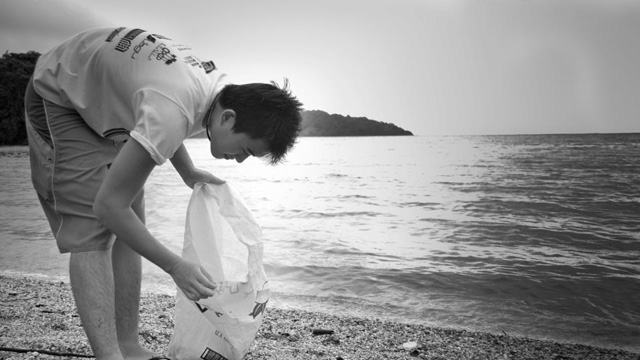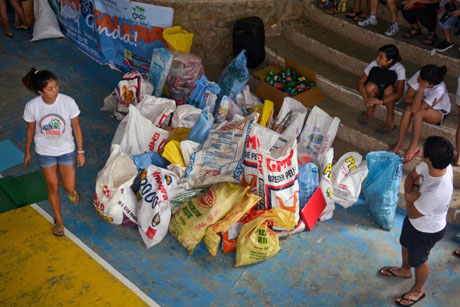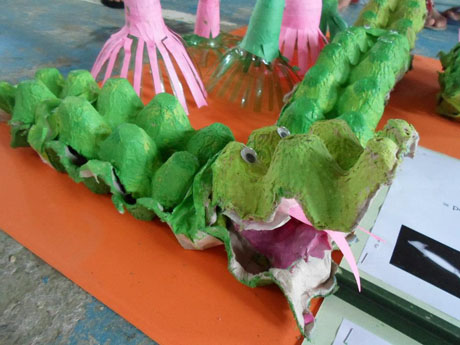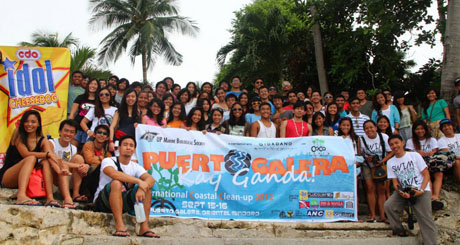SUMMARY
This is AI generated summarization, which may have errors. For context, always refer to the full article.

MANILA, Philippines – It was a race to sunrise as excited chatters were brewing at Jollibee Philcoa right across UP Diliman. One by one, people carrying huge bags and hugging a pair of long rubber fins swung open the glass doors and at once were greeted with overly enthusiastic “Hello”s and “Oy”s, the kind that comes from a combination of excitement and sleep deprivation.
On September 15 to 16, about 60 members and alumni of the UP Marine Biological Society (UP MBS), together with 15 guests, mostly students from UP as well and 3 guests from the event’s sponsor, Giordano, participated in the annual UP MBS International Coastal Cleanup (ICC). This is the organization’s 9th time to participate in the ICC.
The sky was still dark as two busloads of people set on their way to the Batangas port and then to Puerto Galera. This marked the beginning of this year’s ICC: “Puerto Galera, Kay Ganda!”
Trash with names on them
Upon landing, people were immediately deployed to the beaches. Together with 400 students from Puerto Galera, the entire team split into 3 groups which were assigned to 3 beaches: Muelle Cove, Hundura Beach and Balete Beach.

Apart from simply picking up trash and tallying the items collected, the trash collected along the shorelines were segregated into 5 categories: plastics, metals, glass, biodegradables and others.
In coordination with the Puerto Galera local government, these were disposed and the recyclables sold in junk shops.

Kim Lao, an active member of the UP Marine Biological Society (UP MBS) since 2010, organized this year’s UP MBS ICC.
Kim said this year they asked the participants to list down the brands of the items they found. They hope that such data can help not just to spot companies that use packaging that ends up in these beaches, but to push for change.
Having this data would provide a compelling jump-off point on which citizens could urge companies to widen their participation in these kinds of cleanups as a form of social responsibility, as well as lobby for more eco-friendly packaging.

Not just another cleanup
After the cleanup, members and guests alike hopped onto boats and sped north towards the southwest coast of San Antonio island for another environment-saving activity. Participants got down and dirty, their feet gathering mud, as they swung their shovel into the ground to make way for baby mangrove plants.
Why are mangroves so important?
Mangroves filter sediments and dirt and prevent erosion in times of turbulent waves. When the seabed erodes, it kills the corals and destroys homes for the fish. Mangroves are important to corals and the sea’s creatures as trees are important to us in bad weather.
“We need to use the natural environment to clean itself; this is called the ecosystem approach. That’s why we included mangrove planting,” said Kim.
Creative Recycling
Volunteers spent some quality time with the students from Puerto Galera in an arts and crafts session. The students were given recyclable trash such as plasic bottles and egg shells as materials to be made into anything their imaginations would lead them to.
The result?
Jellyfish, crocodiles, and so much more!


A time for firsts
A lot of the guests had little or no experience in open water. A few had the ocean jitters bad. Clarice Fajardo, a kindergarten teacher, was one of the guests.
As we sped towards the dive spot, she clung tightly onto her neon orange life vest as her voice deepend and she muttered under her breath, “It’s my first time in open water… I’m not mentally prepared for this.”
She refused to go down the boat at first but after a lot of nudging from the other participants, Clarice went down, staying afloat in the shallower parts of the water.
Clarice said she loves the outdoors but just started to learn to swim two months ago.
“The event definitely inspired me to learn to skin dive because it exposed me. It’s always been my dream to dive,” she said. “The ambitious me says she wants to try out for UP MBS next year… Ang Kapal ko noh? (I’m ambitious, no?),” she broke into laughter.
“But yeah, there’s nothing like breaking your fears,” she went on, her smile hopeful and brimming with a daredevil-ish glee.

– Rappler.com
Add a comment
How does this make you feel?
There are no comments yet. Add your comment to start the conversation.